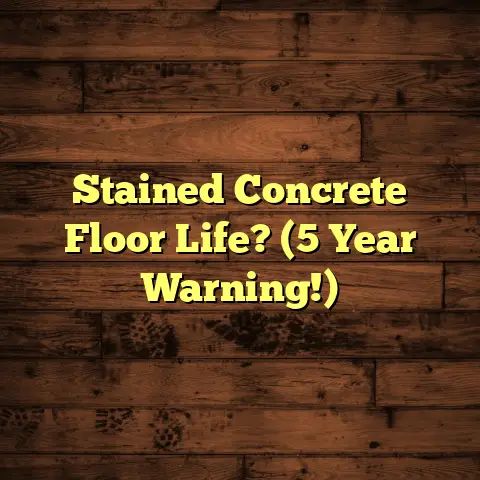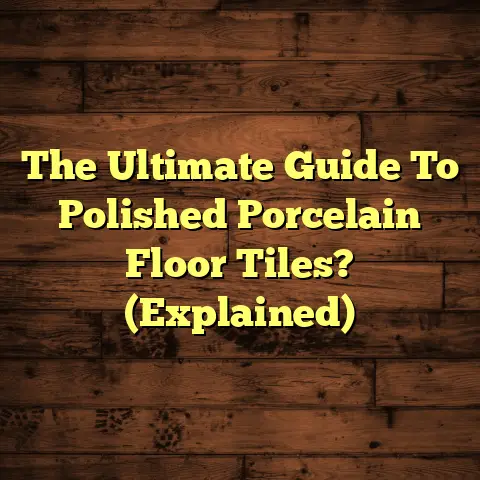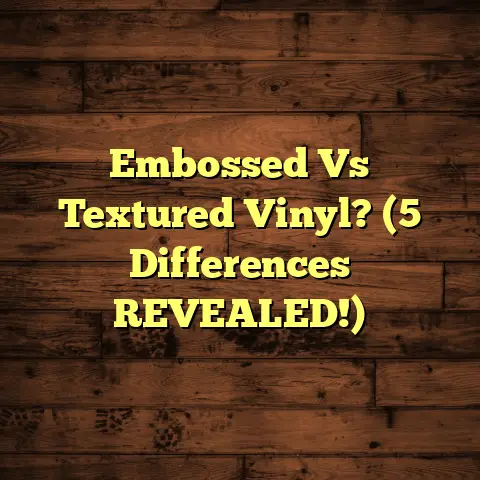Can Cats Ruin Laminate Floors? (3 Fixes Inside!)
And let me tell you, one of the most common questions I get, especially from cat owners, is: “Can cats really ruin laminate floors?”
The short answer? Yes, they can. But don’t panic!
Laminate flooring is a fantastic choice for homes with pets.
It’s affordable, easy to clean, and looks great.
But those adorable felines of ours?
They can pose a few challenges with their claws, occasional accidents, and playful zoomies.
Think scratches, stains, and even dents.
In this article, I’m going to break down exactly how cats can damage your laminate, and more importantly, give you 3 practical fixes you can do yourself.
No need to rip up your floors just yet!
We’ll cover everything from scratch repair kits to behavioral tweaks.
These are easy-to-use solutions that any cat owner can implement.
So, let’s dive in and keep those floors looking purr-fect!
1. Understanding How Cats Can Damage Laminate Floors
Okay, let’s get real. Cats are amazing, but their natural instincts aren’t always laminate-friendly.
It’s not their fault, of course!
It’s up to us to understand their behavior and protect our floors.
1.1 Scratching
Ah, scratching. It’s as natural to cats as breathing.
But those sharp claws and your beautiful laminate? Not the best combo.
Let’s talk about cat claws for a sec. They’re not just for show.
Cats scratch to:
- Sharpen their claws: They shed the outer layer, revealing a fresh, sharp claw underneath.
- Mark their territory: Scratching leaves both a visual mark and a scent (they have scent glands in their paws).
- Stretch their muscles: It’s like a kitty yoga session.
- Relieve stress or boredom: Sometimes, they just feel like it!
Now, why is laminate so susceptible to scratches?
Well, while it’s durable, laminate has a wear layer – a thin, clear coating that protects the printed design underneath.
Cat claws can easily penetrate this layer, leaving visible scratches.
I’ve seen countless floors where a cat’s favorite scratching spot is right in front of a window or near their food bowl.
It’s all about territory and routine!
According to the American Veterinary Medical Association, providing appropriate scratching surfaces can significantly reduce unwanted scratching behavior.
- Pro Tip: Consider observing your cat’s scratching habits.
Where do they scratch the most?
What kind of surfaces do they prefer?
This will help you understand their needs and redirect their behavior.
1.2 Stains and Accidents
Let’s face it: accidents happen.
Whether it’s a hairball, a spilled water bowl, or (heaven forbid) a urine stain, liquids can be a laminate’s worst enemy.
The problem? While laminate is water-resistant, it’s not entirely waterproof.
Some laminate finishes have a porous nature.
This means liquids can seep into the seams between planks or even through tiny imperfections in the surface.
Once that happens, you’re looking at potential staining, swelling, and even mold growth.
Urine is especially problematic.
Its acidic nature can damage the wear layer and leave a lingering odor that’s tough to get rid of.
And trust me, cats have an amazing sense of smell.
If they can still smell their “accident,” they’re more likely to repeat it in the same spot.
I remember one client who tried everything to get rid of a urine stain.
They used every cleaner imaginable, but the smell kept coming back.
Eventually, they had to replace the affected planks to solve the problem completely.
- Fun Fact: Did you know that a cat’s sense of smell is about 14 times stronger than a human’s?
That’s why it’s crucial to clean up accidents thoroughly and use enzymatic cleaners that break down the odor molecules.
1.3 Impact of Heavy Furniture and Play
It’s not just claws and accidents that can damage laminate.
Sometimes, it’s the everyday wear and tear from furniture and playful antics.
Think about it: How often do you move your furniture around?
Even with furniture pads, heavy pieces can leave dents or scratches, especially if you’re dragging them across the floor.
And what about those crazy cat zoomies?
Cats love to run, jump, and slide across the floor, especially when they’re playing.
All that running and jumping can put a lot of stress on the laminate, leading to chipping or denting.
I’ve seen cases where cats jumping from high shelves have actually chipped the edges of laminate planks.
It’s like a tiny impact crater!
Even seemingly harmless activities, like a cat batting around a toy, can cause scratches over time if the toy has a rough surface.
- Personal Story: I once had a client who was convinced her cat was possessed.
She kept finding new scratches on her laminate, but she never saw the cat doing it.
Turns out, the cat was obsessed with a toy mouse that had a small, sharp piece of plastic glued to its nose.
Every time the cat batted the mouse around, it was scratching the floor!
2. Practical Fixes for Cat-Related Laminate Floor Damage
Alright, enough doom and gloom! Let’s talk about solutions.
Here are 3 practical fixes you can use to repair cat-related damage to your laminate floors:
2.1 Scratch Repair Kits
Scratch repair kits are your first line of defense against those pesky claw marks.
These kits typically include a variety of colored wax sticks or fillers that you can use to fill in the scratches and blend them with the surrounding laminate.
Here’s how to use them effectively:
- Clean the area: Use a soft cloth and a mild cleaner to remove any dirt or debris from the scratch.
- Choose the right color: Select a wax stick or filler that closely matches the color of your laminate.
Most kits come with multiple colors that you can mix to create a custom match. - Apply the filler: Use a putty knife or applicator to press the filler into the scratch.
Make sure to overfill the scratch slightly. - Remove excess filler: Use the edge of the putty knife to scrape away any excess filler, making it flush with the surrounding laminate.
- Blend the repair: Use a soft cloth to gently buff the repaired area, blending it with the surrounding laminate.
- Apply a sealant (optional): Some kits include a sealant that you can apply to protect the repaired area.
Product Recommendations:
- Mohawk Finishing Products Fil-Stik Wood Repair Putty Stick: This is a popular choice for its wide range of colors and ease of use.
- Minwax Blend-Fil Pencil: These pencils are great for filling in small scratches and nicks.
- Cal-Flor Scratch Cure: This kit includes a clear liquid that fills in scratches and dries to a hard, durable finish.
Tips for Best Results:
- Test the color in an inconspicuous area first: This will ensure that you’re happy with the color match before you apply it to the scratch.
- Work in thin layers: It’s better to apply multiple thin layers of filler than one thick layer.
This will prevent the filler from cracking or shrinking. - Use a heat gun (optional): If you’re using a wax-based filler, you can use a heat gun to soften the wax and make it easier to apply.
Just be careful not to overheat the wax, as this can damage the laminate.
2.2 Protective Coatings
Think of protective coatings as a shield for your laminate floors.
These coatings are designed to create a durable barrier that protects against scratches, stains, and other types of damage.
There are two main types of protective coatings:
- Sealants: These are typically water-based or oil-based liquids that penetrate the surface of the laminate and create a protective layer.
- Finishes: These are typically polyurethane-based coatings that create a hard, durable surface on top of the laminate.
Benefits of Using Protective Coatings:
- Increased scratch resistance: Coatings can significantly reduce the risk of scratches from cat claws, furniture, and other sources.
- Improved stain resistance: Coatings can prevent liquids from seeping into the laminate and causing stains.
- Enhanced durability: Coatings can extend the life of your laminate floors by protecting them from wear and tear.
- Easier cleaning: Coated floors are easier to clean and maintain.
How to Apply Protective Coatings:
- Prepare the floor: Thoroughly clean the floor with a laminate floor cleaner.
Make sure to remove any dirt, dust, or debris. - Apply the coating: Use a paint roller or applicator pad to apply a thin, even coat of the coating to the floor.
- Allow the coating to dry: Follow the manufacturer’s instructions for drying time.
Most coatings require at least 24 hours to dry completely. - Apply a second coat (optional): For added protection, you can apply a second coat of the coating after the first coat has dried.
Product Recommendations:
- Rejuvenate All Floors Restorer: This is a popular water-based sealant that provides excellent scratch and stain resistance.
- Bona Traffic HD: This is a high-performance polyurethane finish that is designed for commercial use but can also be used in residential settings.
- Armstrong Shinekeeper: This is a budget-friendly sealant that provides good protection against scratches and stains.
Important Considerations:
- Choose a coating that is specifically designed for laminate floors: Using the wrong type of coating can damage your floors.
- Follow the manufacturer’s instructions carefully: This will ensure that you apply the coating correctly and achieve the best results.
- Test the coating in an inconspicuous area first: This will ensure that you’re happy with the appearance of the coating before you apply it to the entire floor.
2.3 Behavioral Modifications
Okay, let’s talk about the root of the problem: your cat’s behavior.
While scratch repair kits and protective coatings can help, they’re not a substitute for addressing the underlying reasons why your cat is scratching or having accidents on your laminate floors.
Here are some strategies for modifying your cat’s behavior:
- Provide plenty of scratching posts: Cats need to scratch.
It’s a natural instinct.
Provide them with plenty of scratching posts in different styles (e.g., vertical, horizontal, cardboard, sisal) and place them in areas where they like to scratch. - Make the scratching posts appealing: Sprinkle catnip on the scratching posts or hang toys from them to make them more attractive to your cat.
- Redirect unwanted scratching: When you see your cat scratching on the laminate, gently redirect them to a scratching post.
You can use a toy or treat to lure them to the post. - Use deterrents: If your cat is scratching in a specific area, you can use deterrents to discourage them from scratching there.
Some popular deterrents include double-sided tape, aluminum foil, and citrus-scented sprays. - Clean up accidents thoroughly: As I mentioned earlier, cats have a strong sense of smell.
If they can still smell their urine on the floor, they’re more likely to repeat the accident in the same spot.
Use an enzymatic cleaner to break down the odor molecules. - Rule out medical issues: If your cat is suddenly having accidents outside of the litter box, it’s important to rule out any medical issues.
Take your cat to the vet for a checkup. - Provide a clean and accessible litter box: Make sure your cat’s litter box is clean and easily accessible.
Some cats are picky about their litter box and will avoid using it if it’s not to their liking. - Reduce stress: Stress can contribute to unwanted behaviors in cats.
Try to identify and reduce any stressors in your cat’s environment.
This could include loud noises, changes in routine, or conflicts with other pets.
Creating a Cat-Friendly Environment:
- Provide vertical space: Cats love to climb and perch.
Provide them with plenty of vertical space, such as cat trees, shelves, and window perches. - Offer plenty of toys: Cats need to play to stay mentally and physically stimulated.
Provide them with a variety of toys, such as balls, mice, and feather wands. - Create a safe and comfortable space: Cats need a place where they can feel safe and secure.
Provide them with a comfortable bed or hiding spot where they can retreat when they feel stressed or overwhelmed.
3. Long-Term Maintenance Tips for Laminate Floors with Cats
Alright, you’ve repaired the damage and modified your cat’s behavior.
Now, let’s talk about how to keep your laminate floors looking great for years to come.
3.1 Regular Cleaning Routines
Regular cleaning is essential for maintaining the beauty and durability of your laminate floors.
Dirt and debris can act like sandpaper, scratching the surface of the laminate over time.
Here’s a simple cleaning routine to follow:
- Sweep or vacuum regularly: Sweep or vacuum your floors at least once a week to remove dirt, dust, and pet hair.
Use a soft-bristled broom or a vacuum with a hard floor attachment to avoid scratching the laminate. - Mop with a laminate floor cleaner: Mop your floors with a laminate floor cleaner every 1-2 weeks.
Use a microfiber mop and avoid using too much water, as this can damage the laminate. - Clean up spills immediately: Wipe up spills as soon as they happen to prevent staining.
Use a soft cloth and a laminate floor cleaner. - Avoid harsh chemicals: Avoid using harsh chemicals, such as bleach or ammonia, on your laminate floors.
These chemicals can damage the finish and cause discoloration.
Pet-Safe Cleaning Products:
- Nature’s Miracle Hard Floor Cleaner: This cleaner is specifically designed for cleaning up pet messes and is safe for use around pets.
- Bona Hardwood Floor Cleaner: This cleaner is safe for use on laminate floors and is effective at removing dirt and grime.
- Puracy Multi-Surface Cleaner: This cleaner is made with plant-based ingredients and is safe for use around pets and children.
3.2 Monitoring and Early Intervention
Regularly inspect your laminate floors for any signs of wear and tear, such as scratches, dents, or stains.
The sooner you address these issues, the easier they will be to fix.
- Check for scratches: Look for scratches in high-traffic areas, such as hallways and doorways.
Use a scratch repair kit to fill in any scratches as soon as you notice them. - Look for stains: Check for stains around pet feeding areas and litter boxes.
Clean up any stains immediately with a laminate floor cleaner. - Inspect for dents: Look for dents caused by furniture or dropped objects.
Use furniture pads to protect your floors from dents. - Address any issues promptly: Don’t wait until the damage gets worse.
The sooner you address any issues, the easier and less expensive they will be to fix.
3.3 Choosing the Right Laminate Flooring
If you’re planning to install new laminate flooring, consider choosing a cat-friendly option.
Look for laminate flooring with the following features:
- High wear layer: The wear layer is the top layer of the laminate that protects it from scratches and wear.
Choose a laminate with a thick wear layer (at least 12mm) for added durability. - Scratch-resistant finish: Some laminate flooring is treated with a scratch-resistant finish that can help to prevent scratches from cat claws.
- Water-resistant core: A water-resistant core will help to prevent damage from spills and accidents.
- Textured surface: A textured surface can help to hide scratches and dents.
Popular Cat-Friendly Laminate Flooring Options:
- Pergo Outlast+: This laminate flooring is known for its exceptional water resistance and scratch resistance.
- Shaw Repel Water-Resistant Laminate: This laminate flooring is designed to repel water and resist stains.
- Mohawk RevWood Plus: This laminate flooring is known for its realistic wood look and its scratch-resistant finish.
Conclusion
So, can cats ruin laminate floors?
Yes, they can.
But with the right knowledge, tools, and strategies, you can protect your floors and enjoy the companionship of your feline friends without sacrificing your home’s beauty.
Remember, it’s all about understanding your cat’s behavior, providing them with appropriate outlets for their natural instincts, and maintaining a regular cleaning routine.
By following the tips and advice in this article, you can keep your laminate floors looking purr-fect for years to come!
Don’t be afraid to embrace your inner DIYer and tackle those scratches and stains head-on.
With a little effort, you can have beautiful, cat-friendly floors that you and your furry companions will love.
And if you ever need help, don’t hesitate to call a professional flooring contractor like myself.
We’re always here to help you keep your floors looking their best!





